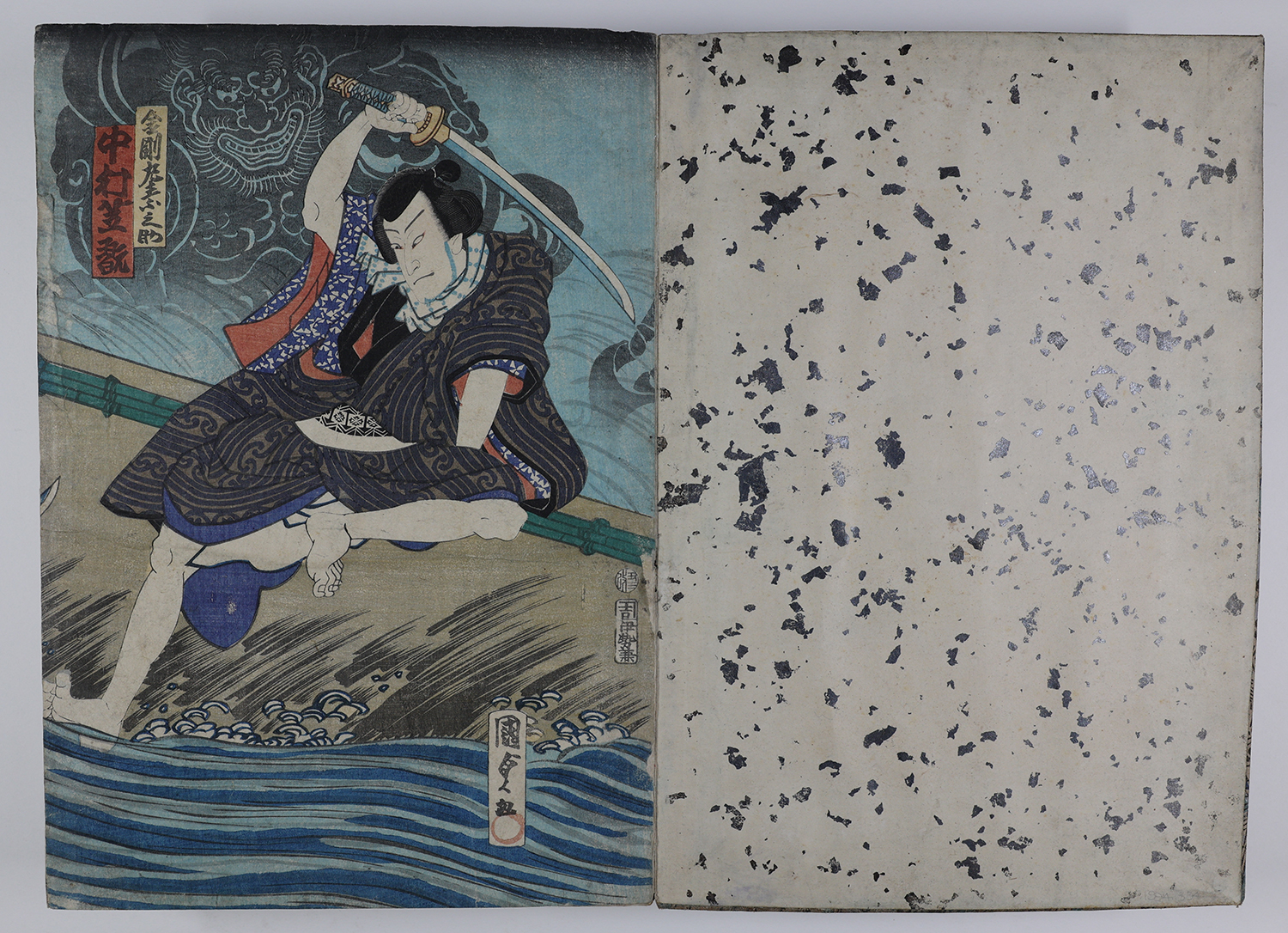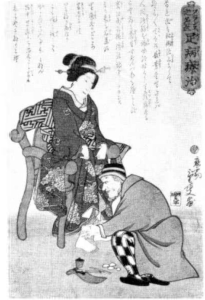Plates 01-03: Triptych of actors Ichikawa Kuzo II, Sawamura Tanosuke III, and Nakamura Shikan IV
Plates 01-03: Triptych of actors Ichikawa Kuzo II, Sawamura Tanosuke III, and Nakamura Shikan IV


Utagawa Kunisada II 歌川国貞 (Toyokuni IV) (1823-1880)
Triptych of actors Ichikawa Kuzo II, Sawamura Tanosuke III, and Nakamura Shikan IV (1865)
Ink and color on paper
Seals:
Publisher: Iseya Kanekichi
Censor: Ox 2 Aratame
Carver: Unknown
Artist: Kunisada ga
This triptych depicts an 1865 performance of Kawatake Mokuami’s 河竹黙阿弥 (1816-1893) play Ichibannori meiki no sashimono. The actor Nakamura Shikan IV 四代目中村芝翫 (1831-1899) holds a sword above his head in the right panel, while Ichikawa Kuzō II 二代目市川九蔵 (1800-1871) does the same on the left. In the center, the onnagata (a male actor who portrayed female roles) Sawamura Tanosuke III 三代目沢村田之助 (1845-1878) plays the protagonist Kakezara. In the background, the fierce Buddhist deity Fudo Myō-ō looms over the scene. The play is a reworking of a folk tale in which Kakezara is a Cinderella-like character.1
The scene represented here, a sword battle set on a rooftop during a powerful flood, is perhaps the most famous aspect of the play itself. The flood effect was an impressive technical feat, inspiring more ukiyo-e depictions than any other scene from the work. To achieve the effect, waves were drawn on the backcloth behind the stage, and the jigasuri 地がすり (the cloth that covers the ground) undulated to represent more waves. Further cloths stretched from the stage into the boxes in the audience, while three partitions called nami-tesuri 波手すり (wave-fences) filled the stage as actors moved between them during the performance.2
Today, Ichibannori meiki no sashimono is mainly known not for its story or its technical innovation, but instead for its tragic role in the life of Sawamura Tanosuke III, who was well-known in Edo for his skillful portrayals of female characters and makes an appearance multiple times in the works within the Pendergrass Compilation Album. Prior to the staging of the scene that is depicted in this ukiyo-e print, a rope that was holding Tanosuke in the air above the stage broke, and he fell to the ground in front of the audience at Morita-za. His foot landed on a nail on the cluttered stage, but he and Seki Sanjūrō (who was portraying the evil stepmother Kataomoi) were able to continue the scene as Tanosuke began to bleed. When the curtain closed, Tanosuke saw a doctor, who wrapped his wound before he went onstage to finish his performance. Upon the play’s completion, Tanosuke collapsed. Despite this, he returned to the stage the next day and completed the three-month run of Ichibannori meiki no sashimono before taking time off to recover.3 The swordfight during the flood was the most physically taxing part of the play, and Tanosuke would have been in immense pain during the performance that Kunisada depicts here.
Unfortunately for Tanosuke, the rigor of these performances prevented his foot from healing properly. His gangrenous leg would continue to worsen until it had to be amputated two years later in 1867. The operation, documented in the print below, was performed by Dr. James Curtis Hepburn. Hepburn provided Tanosuke with an American-made prosthetic leg. As Tanosuke took the stage with the first artificial leg in Japan, Dr. Hepburn’s profile in Japan rose. He would later publish the Hepburn romanization system, which is still the most prominent method of transliterating Japanese to the Latin alphabet today. Sawamura Tanosuke III, however, would soon after lose more limbs to gangrene and die at the age of thirty-three.

Jonathan Caldwell
Economics
Class of 2022
Annotated Bibliography
“Actors Nakamura Shikan IV as Kongômaru Sonosuke (R), Sawamura Tanosuke III as Kakezara (c), and Ichikawa Kuzô III as Wakasa Shinkichi (L).” Museum of Fine Arts, Boston. Accessed March 1, 2022. https://collections.mfa.org/objects/190398.
The MFA’s information on the print, which identifies the actors, characters, play, date, and publisher.
Cummings, Alan. Research question regarding Kawatake play. Personal, February 17, 2022.
Personal e-mail correspondence with a professor who studies and has translated some plays of Kawatake Mokuami. Dr. Cummings identified some other titles that the play used over the years, which later yielded more fruitful information.
Michio, Takaya. “James Curtis Hepburn.” BDCC. Accessed March 1, 2022. http://bdcconline.net/en/stories/hepburn-james-curtis.
This is a summary of James Curtis Hepburn’s life story, written by a Christian missionary group that acts as biographers of figures significant to Christianity in East Asia. Therefore the source is invested in Hepburn’s historical connections to Christianity in Japan. The text claims that the surgery on Tanosuke made Hepburn famous in Japan even before he invented his romanization system.
Nawata, Yuji, and Hans Dethlefs. Performance Spaces and Stage Technologies. Transcript Verlag, 2022.
This contains a description of the stage technology used in the play and situates the print as a depiction of an important scene in the history of kabuki stage effects. It also provides context to what the scene would have actually looked like in a performance.
Takechi H. “History of prostheses and orthoses in Japan.” Prosthetics and orthotics international. 16 issue 2 (1992): 98-103. doi:10.3109/03093649209164319
This text includes a short section situating Tanosuke’s amputation and subsequent prosthetic in the historical context.
